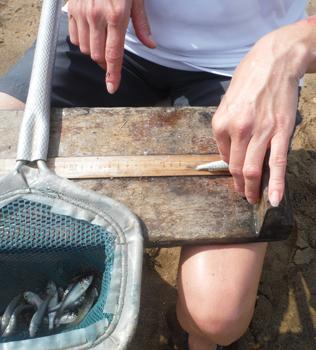 INTRODUCTION: The juvenile striped bass survey documents annual year-class success for
young-of-the-year striped bass (Morone saxatilis) and relative abundance of many other fish species in Chesapeake Bay. Over 100 fish
species have been collected since 1954. Annual indices of relative abundance provide an early indicator of future adult stock
recruitment and document annual variation and long-term trends in abundance and distribution.
INTRODUCTION: The juvenile striped bass survey documents annual year-class success for
young-of-the-year striped bass (Morone saxatilis) and relative abundance of many other fish species in Chesapeake Bay. Over 100 fish
species have been collected since 1954. Annual indices of relative abundance provide an early indicator of future adult stock
recruitment and document annual variation and long-term trends in abundance and distribution.
SAMPLE AREA and INTENSITY: Juvenile indices are derived annually from sampling at 22 fixed stations within Maryland's portion of the Chesapeake Bay. Stations have been sampled continuously since 1954, with changes in some station locations. They are divided among four of the major spawning and nursery areas: seven each in the Potomac River and Head of Bay areas and four each in the Nanticoke and Choptank Rivers. Sampling is monthly, with rounds (sampling excursions) occurring during July (Round I), August (Round II), and September (Round III). Replicate
seine hauls, a minimum of thirty minutes apart, are taken at each site on each sample round. This produces a total of 132 samples from which bay-wide means are calculated. From 1954 to 1961, juvenile surveys included various stations and rounds. Sample sizes ranged from 34 to 46. Present indices derived for this period include only stations which are consistent with subsequent years. In 1962, stations were standardized and a second sample round was added for a total of 88 samples. A third sample round, added in 1966, increased sample size to 132. Auxiliary stations have been sampled on an inconsistent basis and are not included in survey indices. These data enhance geographical coverage in rivers with permanent stations or provide information from other river systems. They are also useful for replacement of permanent stations when necessary.
They are divided among four of the major spawning and nursery areas: seven each in the Potomac River and Head of Bay areas and four each in the Nanticoke and Choptank Rivers. Sampling is monthly, with rounds (sampling excursions) occurring during July (Round I), August (Round II), and September (Round III). Replicate
seine hauls, a minimum of thirty minutes apart, are taken at each site on each sample round. This produces a total of 132 samples from which bay-wide means are calculated. From 1954 to 1961, juvenile surveys included various stations and rounds. Sample sizes ranged from 34 to 46. Present indices derived for this period include only stations which are consistent with subsequent years. In 1962, stations were standardized and a second sample round was added for a total of 88 samples. A third sample round, added in 1966, increased sample size to 132. Auxiliary stations have been sampled on an inconsistent basis and are not included in survey indices. These data enhance geographical coverage in rivers with permanent stations or provide information from other river systems. They are also useful for replacement of permanent stations when necessary.
Video Describing Juvenile Striped Bass Survey Protocol
SAMPLE PROTOCOL: A 30.5-m x 1.24-m bagless beach
seine of untreated 6.4-mm bar mesh was set by hand. One end was held on shore. The other was fully stretched perpendicular from the beach and swept with the current. Ideally, the area swept was equivalent to a 729 m2 quadrant. When depths of 1.6-m or greater were encountered, the offshore end was deployed along this depth contour. An estimate of distance from the beach to this depth was recorded. Striped bass and selected other species were separated into age 0 and age 1+ groupings. Ages were assigned from
length-frequencies and verified through scale examination. The age 0 fish were measured from a random sample of up to 30 individuals per site and round. All other finfish were identified to species and counted. Additional data were collected at each site and sample round. These included: time of first haul, maximum distance from shore, weather, maximum depth, surface water temperature (degrees Celcius), tide stage, surface salinity (ppt), primary and secondary bottom substrates, and percent of submerged aquatic vegetation within the sample area. Dissolved oxygen, pH, and turbidity (secchi disk) were added in 1997.
Fish Abundance Indices
Relative abundance of data and graphs for a particular species. The fifteen most commonly requested species are pictured. Data is presented in an Excel file which can be downloaded by clicking "Save As" on your browser. Each file contains data and graphs for the Chesapeake Bay (includes all areas sampled), Choptank River, Head of Bay area, Nanticoke River, and Potomac River. Each system appears in a separate worksheet. Although system-specific indices appear for each species, they may not always be appropriate. For example: only one site on the Choptank River is of low enough salinity to be considered good habitat for juvenile yellow perch. Indices of relative abundance are presented as Geometric Mean Catch per Haul. The Geometric Mean has been adopted by the Atlantic States Marine Fisheries Commission as the preferred
index of relative abundance.
of data and graphs for a particular species. The fifteen most commonly requested species are pictured. Data is presented in an Excel file which can be downloaded by clicking "Save As" on your browser. Each file contains data and graphs for the Chesapeake Bay (includes all areas sampled), Choptank River, Head of Bay area, Nanticoke River, and Potomac River. Each system appears in a separate worksheet. Although system-specific indices appear for each species, they may not always be appropriate. For example: only one site on the Choptank River is of low enough salinity to be considered good habitat for juvenile yellow perch. Indices of relative abundance are presented as Geometric Mean Catch per Haul. The Geometric Mean has been adopted by the Atlantic States Marine Fisheries Commission as the preferred
index of relative abundance.
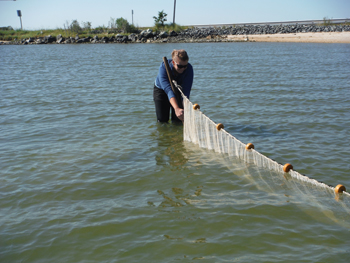
The Geometric Mean is a statistical way of handling the data that is more precise than the Arithmetic Mean Catch per Haul because it is not as sensitive to a single large sample value. The Arithmetic Mean Catch per Haul is presented for striped bass because it is the most widely recognized and easily understood juvenile index. Also appearing in the data tables are: year, number of samples (n), and 95 %
confidence intervals.
All information and data from this web site
should be cited as:
Durell, E.Q., and Weedon, C. 2025. Striped Bass Seine Survey Juvenile Index Web Page.
https://dnr.maryland.gov/fisheries/pages/striped-bass/juvenile-index.aspx. Maryland Department of Natural Resources, Fishing and Boating Services.
Please send comments or questions to project leader
Eric Q. Durell.
 Alewife Herring (YOY): An
anadromous species, important as forage. Alewife and Blueback Herring are often referred to collectively as river herring. The alewife is differentiated by its large eye, deep body, and mottled grey
peritoneum .
Alewife Herring (YOY): An
anadromous species, important as forage. Alewife and Blueback Herring are often referred to collectively as river herring. The alewife is differentiated by its large eye, deep body, and mottled grey
peritoneum .
 Abundance Data and Graphs,
Fish Facts
Abundance Data and Graphs,
Fish Facts
 American shad (YOY): An
anadromous species which lives its adult life in the ocean. Although highly valued for its flesh and
roe by commercial and recreational anglers, this species is currently under moratorium. Also known locally as white shad.
American shad (YOY): An
anadromous species which lives its adult life in the ocean. Although highly valued for its flesh and
roe by commercial and recreational anglers, this species is currently under moratorium. Also known locally as white shad.
 Abundance Data and Graphs,
Fish Facts
Abundance Data and Graphs,
Fish Facts
 Atlantic Croaker: A bottom-feeding species targeted by significant commercial and recreational fisheries. Like other members of the drum family, the croaker can produce loud croaking noises with its air bladder. Also known locally as hardhead.
Atlantic Croaker: A bottom-feeding species targeted by significant commercial and recreational fisheries. Like other members of the drum family, the croaker can produce loud croaking noises with its air bladder. Also known locally as hardhead.
 Abundance Data and Graphs,
Fish Facts
Abundance Data and Graphs,
Fish Facts
 Atlantic Menhaden: A widely distributed species important as forage. Spawning takes place in coastal waters of the mid-Atlantic. Supports a fertilizer and fish oil industry based in Reedville, Virginia. Harvested in Maryland water primarily for use as bait. Also known locally as buggie, bunker, and alewife.
Atlantic Menhaden: A widely distributed species important as forage. Spawning takes place in coastal waters of the mid-Atlantic. Supports a fertilizer and fish oil industry based in Reedville, Virginia. Harvested in Maryland water primarily for use as bait. Also known locally as buggie, bunker, and alewife.
 Abundance Data and Graphs,
Fish Facts
Abundance Data and Graphs,
Fish Facts
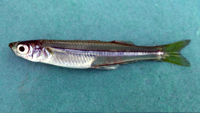 Atlantic Silverside: An abundant and wide spread inhabitant of shallow water which often travels in large schools. Important as forage for predatory fish. Difficult to distinguish from, and often found with, inland silversides and rough silversides. Indices presented are for Atlantic silversides only.
Atlantic Silverside: An abundant and wide spread inhabitant of shallow water which often travels in large schools. Important as forage for predatory fish. Difficult to distinguish from, and often found with, inland silversides and rough silversides. Indices presented are for Atlantic silversides only.
 Abundance Data and Graphs
Abundance Data and Graphs
 Bay Anchovy: A small, nearly transparent species important as forage. Anchovies have remarkably large mouths, which help them strain plankton from the water. This species is often too small to be retained in the
seine until September sampling. We also catch the Striped Anchovy. Only bay anchovy data is posted here.
Bay Anchovy: A small, nearly transparent species important as forage. Anchovies have remarkably large mouths, which help them strain plankton from the water. This species is often too small to be retained in the
seine until September sampling. We also catch the Striped Anchovy. Only bay anchovy data is posted here.
 Abundance Data and Graphs
Abundance Data and Graphs
 Blueback Herring (YOY): An
anadromous species, important as forage. Blueback and alewife herring are often referred to collectively as river herring. The blueback is differentiated by its smaller eye, slender body, and black
peritoneum .
Blueback Herring (YOY): An
anadromous species, important as forage. Blueback and alewife herring are often referred to collectively as river herring. The blueback is differentiated by its smaller eye, slender body, and black
peritoneum .
 Abundance Data and Graphs,
Fish Facts
Abundance Data and Graphs,
Fish Facts
 Bluefish: A wide-ranging species, popular among recreational anglers for the powerful fight it wages when hooked. Razor sharp teeth and a voracious appetite make the bluefish a top predator in Chesapeake Bay. Young fish are called snappers.
Bluefish: A wide-ranging species, popular among recreational anglers for the powerful fight it wages when hooked. Razor sharp teeth and a voracious appetite make the bluefish a top predator in Chesapeake Bay. Young fish are called snappers.
 Abundance Data and Graphs,
Fish Facts
Abundance Data and Graphs,
Fish Facts
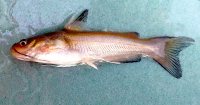 Channel Catfish (YOY): A wide-ranging species which was introduced to our area in the late 1800's. It is identified by its deeply forked tail. Young fish are spotted. This species supports large commercial and recreational fisheries.
Channel Catfish (YOY): A wide-ranging species which was introduced to our area in the late 1800's. It is identified by its deeply forked tail. Young fish are spotted. This species supports large commercial and recreational fisheries.
 Abundance Data and Graphs,
Fish Facts
Abundance Data and Graphs,
Fish Facts
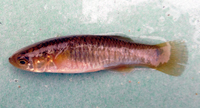 Mummichog: A common member of the killifish family. This stout little fish is important as forage for other predatory species. Sold in large quantities as bait under the name "bull minnow".
Mummichog: A common member of the killifish family. This stout little fish is important as forage for other predatory species. Sold in large quantities as bait under the name "bull minnow".
 Abundance Data and Graphs
Abundance Data and Graphs
 Spot: This bottom-feeding species is a member of the drum family. Males can produce low croaking noises with their air bladders. Small fish are important as forage. Targeted by recreational and commercial anglers.
Spot: This bottom-feeding species is a member of the drum family. Males can produce low croaking noises with their air bladders. Small fish are important as forage. Targeted by recreational and commercial anglers.
 Abundance Data and Graphs,
Fish Facts
Abundance Data and Graphs,
Fish Facts
 Spottail Shiner: A small, schooling minnow that is found in large rivers. Identified by its large eye and a distinct spot at the base of the tail. This spot is often absent on large individuals. Important as forage.
Spottail Shiner: A small, schooling minnow that is found in large rivers. Identified by its large eye and a distinct spot at the base of the tail. This spot is often absent on large individuals. Important as forage.
 Abundance Data and Graphs
Abundance Data and Graphs
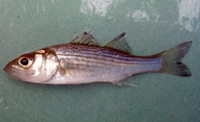 Striped Bass (YOY): An abundant and wide-ranging
anadromous species closely related to the white perch. A top predator in Chesapeake Bay. Supports large commercial and recreational fisheries. Populations collapsed in the 1980's, prompting a five year fishing moratorium. Also known as rockfish, the striped bass is Maryland's state fish.
Striped Bass (YOY): An abundant and wide-ranging
anadromous species closely related to the white perch. A top predator in Chesapeake Bay. Supports large commercial and recreational fisheries. Populations collapsed in the 1980's, prompting a five year fishing moratorium. Also known as rockfish, the striped bass is Maryland's state fish.
 Abundance Data and Graphs (GM),
Abundance Data and Graphs (GM),
 Abundance Data and Graphs (AM),
Fish Facts
Abundance Data and Graphs (AM),
Fish Facts
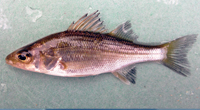 White Perch (YOY): A
semi-anadromous species that spawns in fresh water, but lives its entire life in Chesapeake Bay. Found throughout the bay and its tributaries. Targeted by recreational and commercial anglers almost year-round. Important as forage when small.
White Perch (YOY): A
semi-anadromous species that spawns in fresh water, but lives its entire life in Chesapeake Bay. Found throughout the bay and its tributaries. Targeted by recreational and commercial anglers almost year-round. Important as forage when small.
 Abundance Data and Graphs,
Fish Facts
Abundance Data and Graphs,
Fish Facts
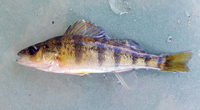 Yellow Perch (YOY): Primarily a fresh water species, but adults tolerate brackish water. Very popular among recreational anglers, who anxiously await spawning runs in early spring. Supports a limited commercial fishery on the Chesapeake Bay.
Yellow Perch (YOY): Primarily a fresh water species, but adults tolerate brackish water. Very popular among recreational anglers, who anxiously await spawning runs in early spring. Supports a limited commercial fishery on the Chesapeake Bay.
 Abundance Data and Graphs,
Fish Facts
Abundance Data and Graphs,
Fish Facts
Created by Craig Weedon and Eric Durell.
Funding Source: USFWS Federal Aid Project F-42-R-16
Send questions or comments to Project Leader:
Eric Durell.
